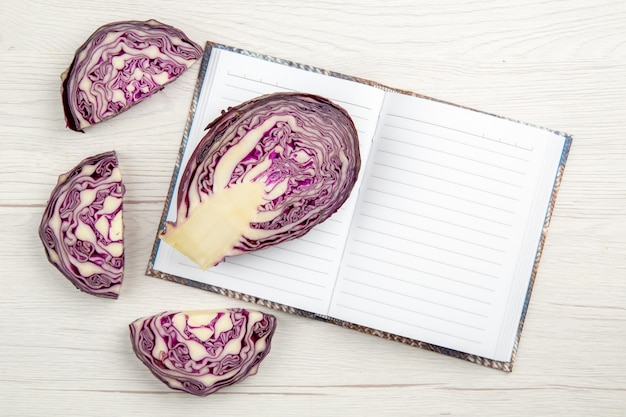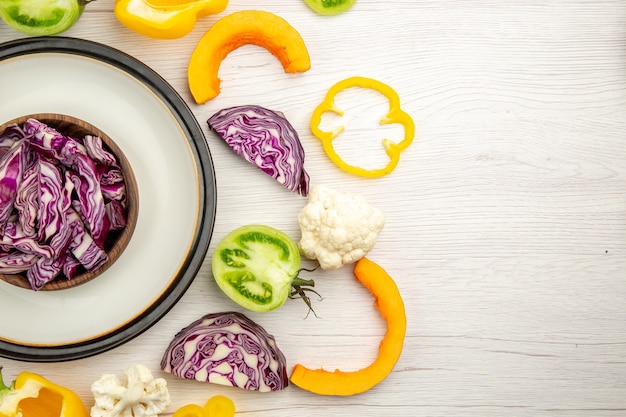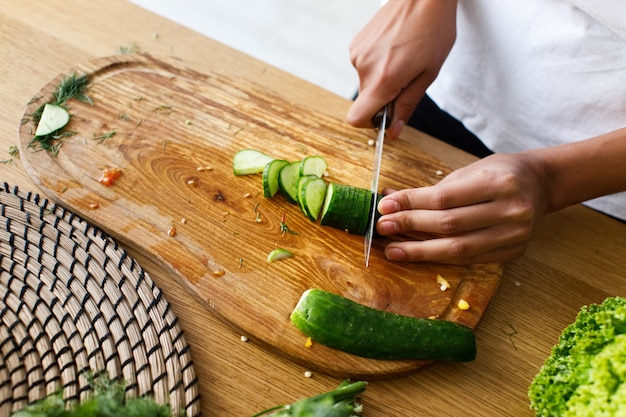(Part 1) Getting to Know Your Cabbage

1. The Classics: White and Green Cabbage
These are the workhorses of the cabbage world. You know them, you love them – the familiar heads that grace countless dishes. While similar in cooking times, white cabbage tends to be firmer, offering a more robust bite.Think about it. If you're whipping up a classic coleslaw, a crisp, shredded white cabbage is the way to go. But if you're making a hearty stew, a green cabbage might be a better choice, holding its shape beautifully in the simmering pot.
2. The Sweet and Spicy: Red Cabbage
This vibrant beauty is a visual and flavourful delight. Its deep red colour adds a touch of drama to any dish, while its inherent sweetness is balanced by a subtle tang. Red cabbage shines in salads and slaws, where its crunch and colour add a welcome pop. However, it also holds its own in braised dishes and stir-fries. Remember, it tends to cook a bit faster than its white or green counterparts.3. The Fancy Stuff: Savoy, Napa, and Bok Choy
Now, we're venturing into the more exotic realm of cabbage. Savoy cabbage, with its distinctive crinkled leaves, adds a delightful textural element to any recipe. Its delicate flavour makes it perfect for roasting or braising. Napa cabbage, with its long, thin leaves, is a staple in Asian cuisine. It lends its subtly sweet flavour to stir-fries, soups, and even salads. And then there's bok choy, a leafy green often grouped with cabbages. Its mild, slightly sweet flavour and quick cooking time make it a versatile ingredient for stir-fries, soups, and even steamed dishes.(Part 2) Cooking Methods: A Tale of Time and Texture

1. Boiling
Boiling is a classic technique for cooking cabbage. It's simple, quick, and a reliable way to soften it. However, be sure to keep a watchful eye on it to avoid overcooking and turning it into mush.A general guideline for boiling cabbage is 5-10 minutes for a whole head, depending on its size and thickness. Smaller heads will cook faster. If you prefer a softer texture, you'll need to boil it for longer.
2. Steaming
Steaming is a healthier way to cook cabbage because it helps preserve nutrients and vibrant colour.Steam your cabbage for 5-8 minutes, depending on the type. You can steam it whole or chop it into wedges. Remember to keep a close eye on it to ensure it doesn't become overcooked.
3. Sautéing
Sautéing is a fantastic way to infuse cabbage with flavour while keeping it quick and easy.Chop your cabbage into thin slices or wedges, heat some oil in a pan, and sauté it over medium heat for about 5-7 minutes until softened and lightly browned.
4. Roasting
Roasting brings out the inherent sweetness of cabbage, giving it a caramelized flavour. It takes a bit longer than sautéing but is worth the extra effort.Cut the cabbage into wedges or chunks, toss it with olive oil, salt, pepper, and any desired spices, and then roast in a preheated oven at 400°F (200°C) for about 20-25 minutes.
(Part 3) Cabbage Cooking Time: A Cheat Sheet

1. Boiling:
White/Green Cabbage: 5-10 minutes Red Cabbage: 4-8 minutes Savoy Cabbage: 7-12 minutes Napa Cabbage: 4-6 minutes Bok Choy: 2-4 minutes2. Steaming:
White/Green Cabbage: 5-8 minutes Red Cabbage: 4-7 minutes Savoy Cabbage: 6-10 minutes Napa Cabbage: 3-5 minutes Bok Choy: 2-3 minutes3. Sautéing:
White/Green Cabbage: 5-7 minutes Red Cabbage: 4-6 minutes Savoy Cabbage: 6-8 minutes Napa Cabbage: 3-5 minutes Bok Choy: 2-3 minutes4. Roasting:
White/Green Cabbage: 20-25 minutes Red Cabbage: 18-22 minutes Savoy Cabbage: 22-27 minutes Napa Cabbage: 15-20 minutes Bok Choy: 10-15 minutes(Part 4) The Art of Testing: When Is It Done?
Don't rely solely on a timer to tell you when your cabbage is done. It's essential to check it throughout the cooking process to ensure it reaches your desired texture.Here are some key signs that your cabbage is ready: For boiling: The cabbage should feel tender when you pierce it with a fork. For steaming: The leaves should be translucent and slightly wilted. For sautéing: The edges should be lightly browned, and the cabbage should be soft. For roasting: The edges should be caramelized, and the cabbage should be tender.
(Part 5) Cabbage cooking tips: Don't Be Afraid to Experiment
Over the years, I've picked up a few tricks of the trade to help you get the most out of your cabbage. Cut cabbage into even pieces: This ensures it cooks evenly throughout. Don't overcrowd the pan: If you're sautéing or roasting, give the cabbage some breathing room. Season generously: Cabbage loves the warmth of salt, pepper, and other herbs and spices. Don't be afraid to experiment: Cabbage is incredibly versatile. Explore different cooking methods, flavour combinations, and recipes to discover your own favourites.(Part 6) cabbage recipes: Inspiration for Your Next Meal
Now, let's get inspired with some of my favourite cabbage recipes that highlight its versatility. braised cabbage with Bacon and Apples: A hearty and flavourful dish that's perfect for a chilly evening. The sweet and savoury combination is simply irresistible. Cabbage Slaw with Creamy Dressing: This refreshing and crunchy side dish is perfect for summer barbecues. It's light, bright, and a welcome addition to any meal. Cabbage and Sausage Soup: A comforting and filling soup that's perfect for a cold day. The earthy flavours of the sausage blend beautifully with the cabbage. stir-fried cabbage with Ginger and Garlic: A quick and easy weeknight meal bursting with flavour. It's a healthy and delicious option that's perfect for a busy weeknight. cabbage rolls with ground beef and Rice: A classic dish that's both delicious and satisfying. It's a hearty meal that will impress your family and friends.(Part 7) cabbage storage: Keeping Your Veggie Fresh
Once you have your cabbage, proper storage is essential to maintain its freshness. Whole heads: Store unwashed cabbage heads in the crisper drawer of your refrigerator for up to 2 weeks. Shredded cabbage: Store shredded cabbage in an airtight container in the fridge for up to 3 days.(Part 8) Cabbage Health Benefits: A Nutrient Powerhouse
Cabbage is not just a delicious vegetable; it's a nutritional powerhouse packed with vitamins, minerals, and antioxidants. Vitamin C: Cabbage is a good source of Vitamin C, an important antioxidant that supports immune function and collagen production. Vitamin K: It also contains Vitamin K, crucial for blood clotting and bone health. Fibre: Cabbage is a great source of dietary fibre, which helps regulate digestion and promote gut health. Antioxidants: Cabbage is packed with antioxidants that help protect cells from damage and reduce the risk of chronic diseases.(Part 9) The History of Cabbage: A Journey Through Time
You might be surprised to learn that cabbage has a rich history stretching back over 2,000 years. It's been cultivated for centuries, making it one of the oldest vegetables in the world.Its origins can be traced back to the Mediterranean region, where it was valued for its versatility and nutritional benefits. Cabbage eventually spread throughout Europe and Asia, becoming a staple in many cuisines.
(Part 10) Cabbage Around the World: Global Delights
Cabbage's global appeal is undeniable. It's used in countless dishes worldwide, reflecting the diverse culinary traditions that have embraced it. Kimchi in Korea: A spicy and fermented cabbage dish that's a national treasure in Korea. Sauerkraut in Germany: A fermented cabbage dish that's a staple in German cuisine. It's often served alongside sausages and pork. Coleslaw in America: A classic side dish that's enjoyed all over the United States. It's typically made with shredded cabbage, mayonnaise, and vinegar. Cabbage Rolls in Eastern Europe: A hearty and flavourful dish that's popular in many Eastern European countries. It's usually filled with ground meat, rice, and spices.(Part 11) Cabbage and Sustainability: A Veggie with a Green Thumb
Cabbage is a sustainable crop that's relatively easy to grow. This makes it a great choice for supporting local farmers and enjoying fresh, seasonal produce.Growing your own cabbage is a rewarding experience, and it allows you to control the quality and freshness of your vegetables. Plus, it's a sustainable and environmentally friendly choice that reduces your carbon footprint.
(Part 12) FAQs
1. Can I freeze cabbage?
Yes, you can freeze cabbage. Blanch it first by boiling it for a few minutes, then plunge it into ice water to stop the cooking process. This preserves its texture and flavour. Once cooled, store it in freezer bags for up to 6 months.2. What happens if I overcook cabbage?
Overcooked cabbage becomes mushy and loses its vibrant flavour. Aim for tender but still slightly firm.3. Can I eat cabbage raw?
Absolutely! Cabbage is delicious raw. It adds a satisfying crunch to salads, slaws, and sandwiches.4. What are some good substitutes for cabbage?
If you're looking for alternatives, consider kale, collard greens, or Swiss chard. They offer similar textures and flavours and can be used in many of the same dishes.5. What is the best way to cook cabbage for a side dish?
Sautéing or roasting cabbage are excellent ways to create a delicious side dish. Toss it with olive oil, salt, pepper, and your favourite spices. You can also add other ingredients like garlic, onions, or bacon to enhance the flavour.There you have it – the ultimate guide to cabbage cooking times! Now you can confidently cook this versatile vegetable and enjoy its deliciousness in countless dishes. Happy cooking, everyone!
Everyone is watching

Prime Rib Roast Cooking Time Chart: Per Pound Guide
Cooking TipsPrime rib roast. Just the name conjures images of lavish dinners, crackling fires, and hearty laughter. It’s ...

How Long to Bake Potatoes in the Oven (Perfect Every Time)
Cooking TipsBaked potatoes are a staple in my kitchen. They're incredibly versatile, delicious, and surprisingly easy to m...

Perfect Rice Every Time: The Ultimate Guide to Cooking Rice
Cooking TipsAs a self-proclaimed foodie, I've always been a bit obsessed with rice. It's the foundation of countless cuisi...

The Ultimate Guide to Cooking Asparagus: Tips, Techniques, and Recipes
Cooking TipsAsparagus. The mere mention of this spring delicacy conjures up images of vibrant green spears, crisp and burs...

Ultimate Guide to Cooking the Perfect Thanksgiving Turkey
Cooking TipsThanksgiving. Just the word conjures up images of overflowing tables laden with delicious food, the scent of r...
